Biophysical variables:
Precipitation is any meteoric water that falls on the earth’s surface in the form of droplets, solid form (snow, hail) and vapor. Precipitation is the most important factor in the hydrological cycle since it is the source of the water that circulates within the basin. The formation of precipitation requires the elevation of a mass of water in the atmosphere in such a way so that it cools and some of its moisture condenses[1]. We can quantify the precipitation fallen at a point using any straight-walled container, then measuring the sheet of water collected. The unit of measurement is the millimeter.
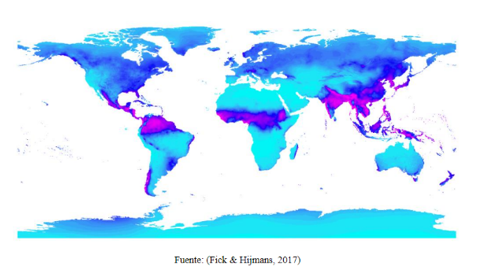 For WaterProof, the database provided by WorldClim on multiannual mean annual mean precipitation data is the most suitable, since it was already built from data from meteorological stations around the world (60,419 stations were used for the construction of the fields); it also makes use of satellite information as a variable to perform the interpolation, in contrast to other databases which are generated purely from satellite products.
For WaterProof, the database provided by WorldClim on multiannual mean annual mean precipitation data is the most suitable, since it was already built from data from meteorological stations around the world (60,419 stations were used for the construction of the fields); it also makes use of satellite information as a variable to perform the interpolation, in contrast to other databases which are generated purely from satellite products.
TWorldClim precipitation fields are located at a spatial resolution of approximately 1 km and comprise the 20-year climatic periods from 1960 to 2018.
The Coefficient of variation of precipitation refers to the statistical operation that allows us to understand the magnitude and variability of the phenomenon. That is, it allows to know if the precipitation measurements move a lot or a little. For its calculation, the mean and the standard deviation of the data series must be obtained and their division must be made [3].
Temperature is the degree of heat or cold in a place. It is the measurement that allows to determine the amount of heat energy accumulated in the air. The temperature depends on various factors, for example, the inclination of the sun's rays. It also depends on the type of substrates (the rock absorbs energy, the ice reflects it), wind direction and strength, latitude, height above sea level, or proximity to bodies of water [4]. Temperature is measured in Centigrade (°C) or Fahrenheit (°F).
Frost days occur when the air temperature is equal to or below the freezing point of water 0°C (WMO, 1992). Ice cover is one of its forms produced by the sublimation of water vapor on objects; it occurs when these temperatures are present (Ascaso and Casasls, 1986). They occur particularly in winter nights due to a strong radiative loss.
Relative humidity is the measurement of the water vapor contained in the air. It is the water vapor that exists in an air mass, expressed as a percentage of the total amount that would exist if the air were saturated at this temperature. It is expressed in integer units ranging from zero (0) to 100% (IDEAM) [5].
Solar brightness is the measurement of the hours of effective sunshine in the day (solar brightness or insolation), which is associated with the amount of time during which the soil surface is irradiated by direct solar radiation [6].
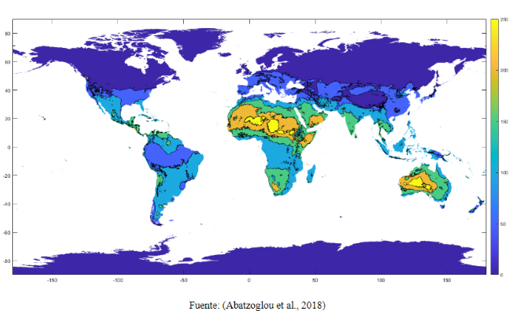 Evapotranspiration is defined as the maximum amount of water that can evaporate from a soil completely covered with vegetation, which develops in optimal conditions, and in the supposed case of no limitations in the availability of water. Evapotranspiration is the sum of the evaporation from the soil surface and the water intercepted by the vegetation, and the transpiration from plants, its knowledge is useful to determine the water requirements of a crop or a region.
Evapotranspiration is defined as the maximum amount of water that can evaporate from a soil completely covered with vegetation, which develops in optimal conditions, and in the supposed case of no limitations in the availability of water. Evapotranspiration is the sum of the evaporation from the soil surface and the water intercepted by the vegetation, and the transpiration from plants, its knowledge is useful to determine the water requirements of a crop or a region.
The database that WaterProof found most appropriate is that of Climatology Lab with its TerraClimate project, since the estimation of this variable is made from the ASCE Penman-Montiethy equation, which is associated with the strict definition of the reference evapotranspiration, which corresponds to the evapotranspiration rate of a hypothetical crop with an assumed crop height (12 cm) and a fixed surface resistance (70 s / m) and albedo (0.23).
On the other hand, the TerraClimate project uses climate-assisted interpolation, combining high spatial resolution climatological normals from the WorldClim dataset (products that are estimated from ground stations), with a coarser spatial resolution, but time-varying data from CRU Ts4.0 and the 55-year Japanese Reanalysis (JRA55). The spatial resolution that TerraClimate presents is approximately 4km and at a temporal level it has records from 1958 to 2018 on a monthly basis.
Levels of the bodies of water is the measurement of the height of the water in rivers, lakes or lagoons, especially useful to know their behavior and identify the magnitude of the changes in the occurrence of floods and inundations. For its measurement a hydrometric scale, installed in a port or in a place of particular interest, is used.
The Flow rate is the volume of water that circulates through the a river channel, and is measured in m3/s. That is, the amount of flowing through a cross section, expressed in volume per unit time [7].
The Rain Erosivity Index is associated with the aggressiveness of the rain on the ground, i.e. the energy with which raindrops impact the soil at a given intensity to break the surface aggregates into particles of transportable size [8].
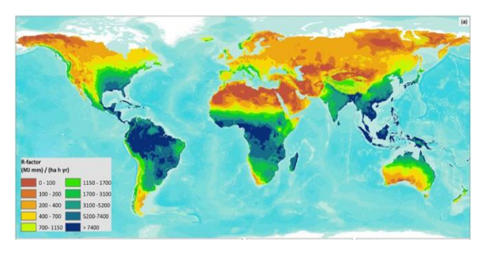 The database used by WaterProof is that of Global Rainfall Erosivity, GloREDa, which offers estimated erosivity values as R-factors of 3,625 stations distributed in 63 countries around the world at a spatial resolution of approximately 1 km. This is the result of an extensive collection of high temporal resolution rainfall data from the maximum possible number of countries to have a representative sample at different climatic and geographic gradients.
The database used by WaterProof is that of Global Rainfall Erosivity, GloREDa, which offers estimated erosivity values as R-factors of 3,625 stations distributed in 63 countries around the world at a spatial resolution of approximately 1 km. This is the result of an extensive collection of high temporal resolution rainfall data from the maximum possible number of countries to have a representative sample at different climatic and geographic gradients.
GloREDa has three components, which are described in the methods section: a) the European-scale Rainros Erosivity database (REDES) 14 b) 1,865 stations from 23 countries outside Europe) 85 stations collected from a literature review (Panagos et al., 2017). Figure 5 shows the global map of rain erosion.
Soil erodibility refers to the susceptibility of the soil to erosion, due to the ease of detachment of soil particles by water or wind, slope and texture class. Erodibility is dynamic, it changes during a storm, during the year, or from year to year. Soils can vary in their moisture content and thus in their resistance to erosion [10].
In this regard, WaterProof did not find any database providing soil erodibility worldwide. However, this variable can be estimated from soil textural data according to the following expression:

Where:
M (silt (%) + very fine sand (%))*(100- clay (%))
an organic matter (%)
b code coverage: 1) highly structured, 2) fairly structured, 3) slightly structured, 4) solid
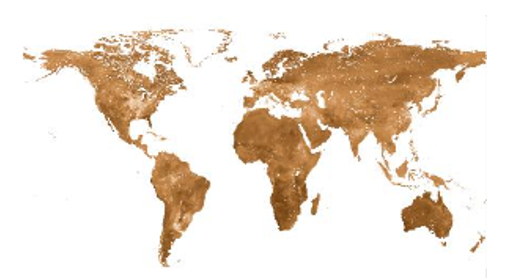 In this sense, the search of databases for this variable was oriented towards textural parameters of the soil. From the review it was found that the ISRIC World Soil Information System provides the contents of sands, silts and clay from all over the world.
In this sense, the search of databases for this variable was oriented towards textural parameters of the soil. From the review it was found that the ISRIC World Soil Information System provides the contents of sands, silts and clay from all over the world.
Textural maps were constructed from over 100,000 soil profiles surveyed around the world and using different covariates including precipitation generated by WorldClim (Hengl et al., 2017). In addition, the soil group, curve number databases make use of the information associated with this database.
Ground depths vary spatially through divergent areas of the landscape by topographic curvatures where there are changes in soil thickness and whose water availability varies between different soil layers or horizons, which makes, for example, that shallow hard sections reduce the possibilities of soil use and tend to become waterlogged in heavy rains. On the other hand, the presence of nutrients also varies according to soil depth, as is the case of potassium and phosphorus, which tend to predominate near the surface, especially in clay soils, while magnesium and calcium characterize more. commonly the lower horizons.
For the use in WaterProof, the estimation of this variable was carried out in conjunction with the soil textural components, as well as the PH, bulk density, cation exchange capacity, among others.
Soil hydrologic groups (SHG) is a set of soils that has a similar behavior towards runoff generation and is classified in one of the following categories [9]:
- Group A: are predominantly sandy soils, where water is transmitted freely through the profile and therefore have a low potential for run-off when completely wet.
- Group B: are soils moderately fine to moderately coarse textured soils that have moderately low potential for runoff when fully wet.
- Group C: are soils with a layer that limits vertical water movement moderately fine to fine textures. Runoff potential for is moderately high when wet.
- Group D: are soils with high potential for runoff and very low infiltration rates. The textures are clayey, the water table is high, or they are shallow soils, settled on impermeable material
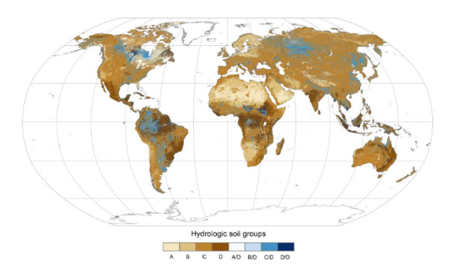 WaterProof considered HYSOGs250m as the most appropriate database, as it offers a globally consistent grid representation with a geographic resolution of 1/480 decimal degrees, corresponding to a projected resolution of approximately 250 m.
WaterProof considered HYSOGs250m as the most appropriate database, as it offers a globally consistent grid representation with a geographic resolution of 1/480 decimal degrees, corresponding to a projected resolution of approximately 250 m.
The HSG classification was derived from the soil texture classes and depth to bedrock provided by the Food and Agriculture Organization (FAO) soilGrids250m system.
The curve number is a hydrological parameter that allows characterizing the runoff potential in a hydrographic basin and is determined from some physical characteristics of the territory such as the type, density and treatment of land covers, as well as by the hydrological soil group.
WaterProof identified only one database associated with the curve numbers. The GCN250 is derived from a combination of the 2015 European Space Agency Global Land Cover Data Set (ESA CCI-LC) sampled at 250 m and the Soil Hydrological Group Global Data Product (HYSOGs250m) released in 2018. The interesting about this database is that it aligns with the hydrological soil group and cover databases that were selected for WaterProof in the previous paragraphs.
GCN250 is based on a look-up table based on the mapping of ESA CCI-LC land cover classes with 630 Hydrology Land Cover Classes (NEH-630); to then (2) resample the raster ESA CCI-LC 2015 300 m at spatial resolution ~ 250 m (ESA-CCI LC 250 m); and perform the (3) mapping of CN values (GCN250) at a spatial resolution of ~ 250 according to the data set of hydrological soil groups (HYSOGs250m), the CN lookup table (step 1) and the ESA raster CCI-LC 250m resampled (step 2) (Jaafar et al., 2019).

With a series of steps, the product of curve numbers is generated for (a) Dry, (b) average and (c) wet antecedent runoff conditions,
Plant-available soil water content refers to the total amount of water available for plant uptake, which depends on the soil's capacity to store different amounts of water, which varies according to its basic physical properties such as texture and structure. The total amount of water available in the soil for plants (ADP) is the difference between the maximum water stored at the maximum retention or storage limit known as "Field Capacity" (Cc) and the minimum storage limit, denominated as "Permanent Wilting Point" (PWP), where the moisture content of the soil makes the plant no longer have the ability to absorb water from the soil causing the plant to wilt and die if additional water is not provided.
WaterProof identified only one database named HiHydroSoil. This database provides hydraulic properties of the soil to support hydrological modeling. The maps have a resolution of 1 km.
Bibliography
[1] LA PRECIPITACIÓN. 2021. Universidad de Coruña.. | http://caminos.udc.es/info/asignaturas/grado_itop/415/pdfs/Capitulo%202.pdf
[2] Precipitación. 2021. Universidad de Salamanca. | https://hidrologia.usal.es/temas/Precipitaciones.pdf
[3] Cálculos estadísticos en hidrología. 2013. Snachez F. Universidad de Salamanca, España. | https://hidrologia.usal.es/temas/calculos_esta.pdf
[4] El clima: temperatura, humedad, presión. 2021. https://www.astromia.com/. | https://www.astromia.com/tierraluna/elemclima.htm
[5] Glosario meteorológico. 2019. IDEAM. | http://www.ideam.gov.co/documents/11769/72085840/Anexo+10.+Glosario+meteorol%C3%B3gico.pdf
[6] Brillo Solar. 2017. IDEAM. | http://www.ideam.gov.co/documents/11769/1287468/V1.08+HM+Brillo+Solar.pdf
[7] MEDIClÓN DEL CAUDAL. 2021. IDEAM. | http://documentacion.ideam.gov.co/openbiblio/bvirtual/012406/Cap11.pdf
[9] Chapter 7 Hydrologic Soil Groups - Part 630 Hydrology National Engineering Handbook. 2009. United States Department of Agriculture. | https://directives.sc.egov.usda.gov/OpenNonWebContent.aspx?content=22526.wba
[9] EROSION DEL SUELO. 2021. FAO. | https://www.fao.org/about/meetings/soil-erosion-symposium/key-messages/es/
TerraClimate, a high-resolution global dataset of monthly climate and climatic water balance from 1958–2015. 2018. Abatzoglou, J. T., Dobrowski, S. Z., Parks, S. A., & Hegewisch, K. C.. | https://doi.org/10.1038/sdata.2017.191
Referencies
¿Cómo se forma la precipitación? | https://www.meteorologiaenred.com/las-precipitaciones.html
¿Sabes qué es una helada? | https://www.gob.mx/cenapred/articulos/sabes-que-es-una-helada